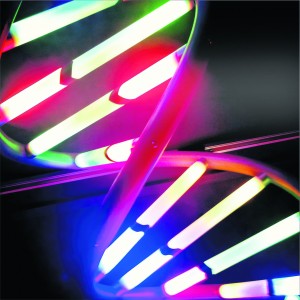WEDNESDAY, 18 JANUARY 2012
Scientists are one step closer to being able to correct mistakes in our DNA, thanks to a newly developed method for rewriting mutations in stem cells. In a recent Nature publication, researchers used piggyBac, a ‘jumping gene’ that can move along DNA, to insert a corrected gene with remarkable precision.Kosuke Yusa and a team at the University of Cambridge focused on using piggyBac to treat a genetic liver disease caused by deficiency in the protein alpha 1-antitrypsin. This deficiency is due to a genetic mutation, found in one in 2000 northern europeans, causing the protein to accumulate in the liver and cause scarring. Yusa’s team converted patient skin cell samples into stem cells and corrected the mutation using piggyBac. The stem cells were then converted into liver cells with a genetic code that could produce the correct form of the protein. Unfortunately, producing stem cells in this fashion introduces other mutations into the DNA. Minimising the risk of new mutations is therefore necessary before the technique can be used to treat patients.
Currently, the only cure for alpha 1-antitrypsin deficiency is a liver transplant. With long transplant waiting lists, the use of piggyBac brings new hope to thousands of sufferers. Ian Le Guillou
DOI: 10.1073/pnas.1018740108
Counterfeiters beware!
Researchers at the Chinese Academy of Sciences in Changchun have developed new nanocrystals that promise to make life difficult for prospective counterfeiters.
These fluorescing nanocrystals are suitable for use in anti-counterfeiting ink because they appear as different colours under different types of light. They display both upconversion, whereby one photon is absorbed and then another is emitted at a higher frequency, and downconversion, whereby a high energy photon is absorbed and emitted as two lower energy photons. Under infrared light, the nanocrystals undergo upconversion, causing them to appear green. However, when ultraviolet light is used, the crystals undergo downconversion and appear blue. This dual emission makes ‘nanocrystal ink’ more difficult to replicate than anti-counterfeiting inks currently in use, which have only a single colour.
During synthesis, the nanoparticles were bound to an organic acid to make them soluble in organic solvents so that they could be stamped onto paper.
The group’s next challenge is to improve the efficiency of their nanocrystals by increasing the number of molecules active in the photon conversion. This would enhance their ability to compete with traditional organic dyes. Stephanie Boardman
DOI: 10.1039/c1nr10752f
Three new planets and a mystery object
An international research team led by Alex Wolszczan—the first person ever to detect planets outside our solar system—has recently discovered three new planets. According to the researchers from Penn State University, each of these planets orbits its own giant star.
Intriguingly, however, the stars at the centre of these miniature solar systems are dying. By following these three stars, the researchers hope to discover more about the ways in which solar systems evolve as their stars die.
One of the stars is accompanied by a gas giant not too different from Jupiter and an additional mystery object. The research team has speculated about the identity of the object, with suggestions ranging from a small planet to one 80 times the size of Jupiter. The researchers will continue to watch the object carefully over the coming years in the hopes of discovering its identity.
Ultimately, these new discoveries should pave the way for a better understanding of the events that occur as a star dies. They also offer clues as to the fate that awaits our own solar system, albeit in some five billion years time. Javier Aziproz-Korban
www.sciencedaily.com/releases/2011/10/111027132502



